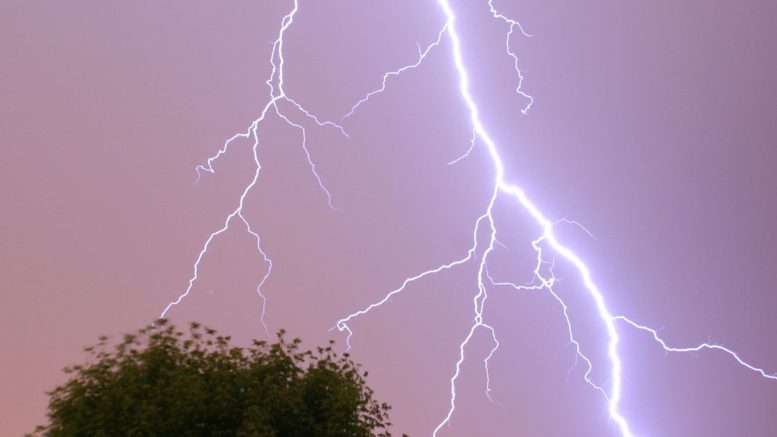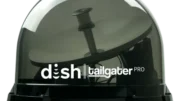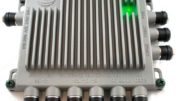Grounding is incredibly important. Often times, an antenna or dish is the highest point in your house and is very attractive to lightning. In a best-case scenario, a lightning strike will destroy all your cool toys. In the worst case it can electrocute you or start a fire that will burn down the house. Even on a sunny day bad grounding can be an issue. Any charge that is built up could travel into your expensive electronics and ruin them.In this guide you will learn how to properly bond and ground a cable, satellite, and/or antenna installation and why it is important. Grounding is an essential part of any low voltage installation. There are many different reasons for grounding, all of which lead to safety. A good ground can protect you, your home, and your equipment from lightening and static build up. Note: You should always research applicable local codes before grounding.
This document is available in PDF format! Download it now!
Materials List
Double-click on any item to see it in a larger size. Click on the item’s name to shop for it at Solid Signal.
Ground Clamp – Used to attach ground wire to the ground rod.
Ground Rod – Must be hammered completely into the ground, used to ground antenna, satellite and cable systems.
Split Bolt – Used to attach ground wire to the ground strand for a home electrical panel.
Copper Ground Strap – Used to attach ground wire to a copper cold water pipe.
Galvanized Ground Strap – Used to attach ground wire to a galvanized cold water pipe.
Ground Block – Used to ground a coaxial run for the purpose of static discharge.
Ground Wire – Must be 10 gauge copper wire, used to ground cable, satellite, and antenna systems.
Tools You’ll Need
Diagonal Cutters – Used to cut ground wire and excess from cold water straps.
Phillips Screwdriver – Used to loosen or tighten screws on grounding materials.
Flathead Screwdriver – Used to loosen or tighten screws on grounding materials.
Why do we ground?
1. Limit voltages due to lightning
One reason to ground the coaxial cable is to prevent lightning from striking the dish. This is NOT to carry the current from a lightning strike safely to ground. In order to do that, the ground wire would have to be the width of a tree trunk to carry the millions of volts and thousands of amps contained in a lightning strike without melting to slag.
Grounding an electrical system has no effect on whether lighting strikes the system or not. A lightning strike spreads energy across a large area in the ground. Any electrical system that is close by can conduct this energy throughout its components.
The grounding system that you would put in place creates a preferred path that can bleed off energy induced onto the system by nearby lightning strikes. Bonding the ODU mount and mast itself, in addition to the coaxial cable is required.
2. Line Surges
This source of over-voltage is, in a properly grounded system, provided with an alternative path around the electrical system of your home or workplace by intentionally connecting the system to the earth. Proper grounding of the antenna mast and lead-in cables is somewhat effective in protecting receiving equipment from voltage transients that result from lightning.
3. Unintentional contact with high voltage lines
Tornadoes, high winds, and strong storms can bring power lines down. Power line insulation can wear over time and can come into contact with nearby objects.
4. Dissipate static electricity
The antenna or satellite ODU sits outside where wind will create a static charge on the dish itself and the wire attached to it. This action is similar to walking across carpet and then touching another object, which causes a difference of potential resulting in transfer of the charge. In the case of your ODU, the dish is the object and the air is the carpet. This charge will build up on the dish and the cable until it reaches a high enough potential that it is able to jump across an air space to ground. Unfortunately, this will usually follow a path that leads through the electronics inside your receiver, or… more commonly, in the LNB on the dish.
With antenna there is a similar issue, except that, in most cases there is no receiver for over-the-air signals and your TV will pay the price.
5. Potential Difference
If the system is not bonded to the main service ground, you could experience an unbalanced ground within the system, which can lead to electronic component failure; or in an extreme case, a large electrical current flowing through your receiver or television. A #10 AWG ground wire MUST be connected to the household electrical service ground. Using an existing ground wire (such as in an AC service panel) can be in violation of electrical code and could be dangerous. Not grounding to the house electrical system leads to a difference in potential between two grounds. This difference in potential can only be equalized at the remaining common point; the receiver or TV! Over time, receiver or TV will fail or lose functionality.
6. Provide a drain for signals and noise captured by the shield of the coaxial cable.
Bonding the shield serves to nullify the effects of stray signals by “grounding out,” or reducing to a zero potential, the voltages which are picked up by the outer shield. This prevents much of that signal potential from reaching the center conductor.
7. Ground Loops
A ground loop occurs when there is more than one bond connection path between two pieces of equipment. The duplicate bonding paths form the equivalent of a loop antenna, which very efficiently picks up interference currents. Lead resistance transforms these currents into voltage fluctuations.
8. Personal injury
A satellite receiver is connected to a 110-volt circuit protected by at least a 15-amp breaker, but with no current limiting device on the neutral or ground leads. The power transformer in the receiver power supply will have its center tap attached to neutral, and the receiver cabinet will be connected to ground.
If the ground used for the coaxial cable, which is also connected to the receiver cabinet, is a better ground than the one used for the electrical service, then the entire house current could potentially, at least partially, flow back through the receiver’s electrical service ground lead. From there, current will flow to the receiver cabinet, through the coaxial cable’s shield, to the grounding block and then to ground. How much current flows depends on the ground potential difference. The potential danger to anyone touching the receiver is extremely serious.
Grounding Requirements
The length of the #10 AWG grounding wire placed between the ground block and the house grounding electrode system must not exceed 20 feet in length or the length from the splitter and/or multi switch to the closest TV. If the ground block is farther than 20 feet from any part of the grounding electrode system, consider rewiring the cable(s) from the antenna or dish to a new ground block location that is within 20 feet of the ground source.
Grounding Antennas
When grounding an antenna you mounted outside, you will want to ground it in 2 ways. First you will want to ground the mast and secondly, you want to ground the coaxial cable.
When grounding the mast, you will use 10 AWG solid copper ground wire. (You can use a #17 AWG if attached to the wire.) To start, you will want to survey the area and find the best possible grounding location. The optimal location is the ground strand coming from the electrical panel, you can do this using a split bolt to attach the ground wire to the strand. NEC standards no longer suggest using corner clamps or cold water spigots for grounding. You can use a ground rod also, but in order for that, you would need to be able to bond to the electrical ground rods using a 6 AWG ground wire.
Grounding the coaxial cable is a little different. In order to do this you will need a ground block. The ground block should be placed outside just before the coaxial cable goes into the house. The ground block has a screw hole to hold the 10 AWG ground wire; you can attach the #17 to the ground block and the #10 to the ground source. You can use any of the methods for ground previously mentioned in the last paragraph, additionally for grounding the coaxial cable, you can use one additional grounding method. You can use ground straps to attach the ground wire to a copper or galvanized cold water pipe inside the house
(note: ground straps come in copper and galvanized, you will need to use copper when grounding to a copper pipe and galvanized when grounding to a galvanized pipe.).
Grounding Satellite Dishes
As with antennas, satellite installations need to be grounded in 2 ways. You will need to ground both the satellite dish and the coaxial cable.
When grounding the satellite dish, you can attach anywhere on the metal part of the metal part of the dish/mast. However, there is a grounding screw on one side the mast base. When grounding the satellite dish, you will use 10 AWG solid copper ground wire; you can use a #17 AWG if attached to the wire. To start, you will want to survey the area and find the best possible grounding location. The optimal location is the ground strand coming from the electrical panel, you can do this using a split bolt to attach the ground wire to the strand. DIRECTV standards do not allow for grounding to a cold water spigot or using a corner clamp. You can use a ground rod also, but in order for that, you would need to be able to bond to the electrical ground rods using a 6 AWG ground wire.
Grounding the coaxial cable is a little different. In order to do this you will need a ground block. The ground block should be placed outside just before the coaxial cable goes into the house. The ground block has a screw hole to hold the 10 AWG ground wire. You can use any of the methods for ground previously mentioned in the last paragraph, additionally for grounding the coaxial cable, you can use one additional grounding method. You can use ground straps to attach the ground wire to a copper or galvanized cold water pipe inside the house
(note: ground straps come in copper and galvanized, you will need to use copper when grounding to a copper pipe and galvanized when grounding to a galvanized pipe. Also, you should be sure it’s a COLD water pipe, NOT a hot water or gas pipe).
Grounding for Cellular Boosters
As with antennas and satellites, the antenna/mast and the coaxial cable for the booster need to be grounded.
When grounding the mast, you will use 10 AWG solid copper ground wire. To start, you will want to survey the area and find the best possible grounding location. The optimal location is the ground strand coming from the electrical panel, you can do this using a split bolt to attach the ground wire to the strand. NEC standards no longer suggest using corner clamps or cold water spigots for grounding. You can use a ground rod also, but in order for that, you would need to be able to bond to the electrical ground rods using a 6 AWG ground wire.
Grounding the cable for cellular boosters is going to be a little different depending which kind of booster you’re using. If you’re using a Wi-Ex product, it will work the same as with a regular antenna. In order to do this you will need a ground block. The ground block should be placed outside just before the coaxial cable goes into the house. The ground block has a screw hole to hold the 10 AWG ground wire. You can use any of the methods for ground previously mentioned in the last paragraph, additionally for grounding the coaxial cable, you can use one additional grounding method. You can use ground straps to attach the ground wire to a copper or galvanized cold water pipe inside the house
(note: ground straps come in copper and galvanized, you will need to use copper when grounding to a copper pipe and galvanized when grounding to a galvanized pipe. Also, you should be sure it’s a COLD water pipe, NOT a hot water or gas pipe). If you are using a Wilson or CellPhone Mate product, you do the same except in place of a ground block, you would need to use a special surge protector, the Wilson 859902.
This document has been revised and updated for 2014! Special thanks go to Scott Keinbrook for original content and Juan Garrido for help with the 2014 revisions.





